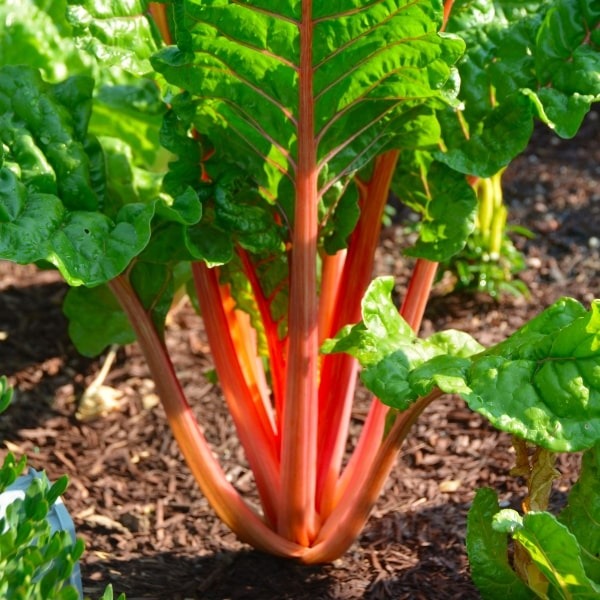Chard ribs : Benefits, recipes and tips | Complete guide
Find out all about chard ribs: nutritional values, preparation tips and tasty recipes. The ultimate guide to cooking and enjoying this versatile vegetable.
VEGETABLES


Swiss chard
Introduction:
Chard ribs, an often overlooked vegetable, deserve a place of honour on our plates and in our vegetable gardens. Nutritious, versatile and easy to grow, they offer a palette of flavours and textures that will delight the taste buds of gourmets and lovers of healthy cooking alike. In this article, we delve into the fascinating world of chard ribs, from their age-old history to their modern uses, as well as their nutritional benefits and growing secrets.
Contents:
Definition and description of chard ribs
Nutritional values and health benefits
Tips for choosing and storing chard chops
Preparation and cooking techniques
Popular recipes (gratins, pan-fried, stuffings)
The difference between chard ribs and chard greens
Chard history and origins
Season and availability
Chard varieties and their characteristics
Growing tips for gardening
1-Definition and description of chard.
Chard, also known as Swiss chard, is the fleshy, edible part of the Swiss chard plant (Beta vulgaris var. cicla). This vegetable, a member of the Chenopodiaceae family, is distinguished by its broad green leaves and thick, crisp stems. The ribs, which can be white, yellow, red or multicolored depending on the variety, are the most widely consumed part of the plant. Their firm texture and slightly sweet taste make them a versatile ingredient in cooking. Rich in fiber, vitamins and minerals, chard ribs offer a tasty and nutritious alternative to spinach or celery. Easy to grow and available almost all year round, these vegetables are gaining in popularity in modern cooking, as much for their gustatory qualities as for their health benefits.
2-Nutritional values and health benefits.
Chard ribs are a nutritional treasure trove, offering a multitude of health benefits. Low in calories (around 19 kcal per 100g), they are rich in fiber, promoting good digestion and a feeling of satiety. Chard ribs are packed with essential vitamins, including vitamin K, which is crucial for blood clotting, vitamin A, which is good for eyesight, and vitamin C, which boosts the immune system. They are also an excellent source of minerals such as potassium, important for blood pressure regulation, and magnesium, essential for bone health. The antioxidants found in chard ribs, such as beta-carotenes and flavonoids, help fight oxidative stress and reduce the risk of chronic disease. What's more, their folic acid content makes them a recommended food for pregnant women. Regularly incorporating chard ribs into your diet can therefore contribute to better cardiovascular health, a stronger immune system and the prevention of certain diseases.
3-Tips for choosing and storing chard ribs.
To make the most of chard ribs, it's essential to know how to choose and store them correctly. When buying, choose chard ribs with firm, crisp stems, free of brown spots and wilted parts. Leaves should be bright green, with no yellowing or wilting. Prefer medium-sized ribs, as larger ones can be fibrous. For optimum freshness, choose chard with white (or colored, depending on variety) ribs and crisp leaves. Once home, store unwashed chard ribs in the refrigerator crisper, wrapped in a damp cloth or perforated bag. This will keep them fresh for 3 to 5 days. For longer storage, you can blanch chard ribs and freeze them for up to 6 months. Before use, wash thoroughly in cold water to remove all traces of soil. By following these tips, you'll ensure the best quality and flavor from your chard chops, whether they're intended for immediate cooking or for longer storage.
4-Preparation and cooking techniques.
The versatility of chard ribs is reflected in their many preparation and cooking techniques. Before cooking, wash chard ribs thoroughly, separating them from the leaves if necessary. For optimum texture, remove fibrous threads by gently peeling. Steaming (5-7 minutes) preserves their nutrients and crunchiness. For a more pronounced flavor, opt for a quick pan-fry (3-5 minutes) in olive oil with garlic. Chard chops also lend themselves well to braising (10-15 minutes) in a fragrant broth, ideal for tenderizing them. For a gratin dish, pre-cook them in boiling water (5 minutes) before putting them in the oven with a béchamel sauce. For creative cooking, try them in tempura for a crunchy appetizer, or incorporate them raw and finely sliced into salads for a fresh note. Chard chops can also be stuffed, like vegetable cannelloni, then baked in the oven. Whichever method you choose, take care not to overcook them to preserve their texture and nutritional benefits.


5-Popular recipes (gratins, pan-fried dishes, stuffings)
Chard ribs lend themselves to a multitude of tasty, easy-to-make recipes.
Chard gratin is a comforting classic:
Alternate layers of blanched ribs with a light béchamel sauce, grated cheese, and gratinate in the oven for a creamy, golden dish.
For a lighter option, try.
Pan-fried chard ribs with pine nuts and raisins:
Sauté chopped ribs with garlic, add roasted pine nuts and raisins for a sweet-savory touch.
Stuffed chard ribs are a great way to impress your guests:
Top them with a mixture of ricotta, Parmesan, fresh herbs and breadcrumbs before baking.
In a quiche, chard ribs go perfectly with lardons and goat's cheese.
For a refreshing starter, prepare a salad of finely chopped raw chard ribs, dressed with a lemon vinaigrette and sprinkled with crushed walnuts.
Don't forget the famous Provencal dish, tian.
Where chops of chard blend harmoniously with other sun-drenched vegetables. These versatile recipes highlight the unique texture and subtle flavor of chard ribs, transforming them into dishes enjoyed by all.
6-Difference between chard rib and green.
Chard, a versatile vegetable, is made up of two distinct parts: the rib and the green, each offering unique characteristics in the kitchen. Chard ribs, the fleshy central part, are distinguished by their crunchy texture and slightly sweet taste. White, yellow or red, depending on the variety, they generally require longer cooking than the leaves. The ribs are similar in texture to stalked celery, and can be used in gratins, pan-fried or as a side dish. Green chard refers to the broad leaves surrounding the ribs. Deep green in color, these leaves have a more pronounced, slightly bitter flavor, reminiscent of spinach. They cook quickly and are ideal for sautéing, soups or as a spinach substitute in a variety of recipes. Rich in chlorophyll, chard greens are particularly nutritious. Although different, these two parts of the chard plant complement each other perfectly and can be used together or separately, offering great culinary and nutritional versatility.
7-History and origins of Swiss chard
Chard, whose ribs are now enjoyed the world over, has a rich history dating back to antiquity. Native to the Mediterranean basin, this vegetable was already being cultivated by Greek and Roman civilizations over 2,000 years ago. The ancient Romans, in particular, prized chard ribs for their gustatory and medicinal qualities. In the Middle Ages, chard spread throughout Europe, gaining popularity in monastic kitchen gardens. It was at this time that the selection of broad-ribbed varieties began, giving rise to the chard ribs we know today. In the 16th century, chard was introduced to America by European explorers, quickly becoming an integral part of local cuisine. In France, it became an emblematic vegetable of Provençal and Nicoise cuisine. Over the centuries, chard cultivation diversified, giving rise to numerous varieties with colorful ribs, ranging from white to red to yellow. Today, chard ribs are enjoying a resurgence in modern cooking, appreciated for their versatility and nutritional benefits, testifying to the enduring appeal of this ancestral vegetable.
8-Consumption season and availability.
Chard ribs stand out for their remarkable year-round availability, offering consumers almost permanent access to this versatile vegetable. Nevertheless, their true peak season runs from spring to autumn, with a peak of freshness and flavor from May to October. During this period, chard ribs are particularly tender and flavorful, ideal for a multitude of culinary preparations. Greenhouse cultivation also enables winter production, ensuring a continuous supply for market stalls and supermarkets. For lovers of local, seasonal produce, we recommend chard chops in late spring and summer, when their flavor is at its peak. Home gardeners can easily grow them in their kitchen gardens, with sowing staggered from March to August for a staggered harvest. This widespread availability makes chard ribs an ingredient of choice for varied, balanced year-round cuisine, equally at home in summer salads or comforting winter gratins.
9-Varieties of chard and their characteristics.
Chard ribs come in many varieties, each offering unique characteristics in terms of color, texture and flavor. Green chard, or “Verte à carde blanche”, is the most common, with its broad white ribs and dark green leaves. It is distinguished by its mild flavor and crunchy texture. Blonde à carde blanche” has lighter green leaves, ideal for delicate preparations. For a touch of color, “Rhubarb Chard” impresses with its bright red ribs and red-veined green leaves, adding a visually appealing note to dishes. The “Bright Lights” variety offers a multicolored spectacle with its yellow, orange, pink and red ribs, perfect for brightening up plates. Lucullus” is characterized by its particularly broad, fleshy white ribs, excellent for gratins. For lovers of stronger flavors, “Verte frisée de Lyon” offers embossed leaves and a robust texture. Last but not least, the “Bali” seduces with its bright yellow ribs, contrasting with its dark green leaves. Each variety of chard brings its own unique touch to the kitchen, allowing chefs and enthusiasts to vary the visual and gustatory pleasures.
10-Growing tips for gardening.
Growing chard ribs in your garden is accessible to all gardeners, novice and experienced alike. To succeed, start by choosing a sunny or semi-shaded spot with rich, well-drained soil. Sow the seeds directly in the ground from March to August, in rows 30 to 40 cm apart, for staggered harvests. Germination takes 8 to 15 days. Thin out plants 20-30 cm apart when they reach 10 cm in height. Chard needs regular watering, especially during dry spells, to prevent it from going to seed. Mulching around the plants helps conserve moisture and limit weeds. Fertilize moderately with a nitrogen-rich organic fertilizer. Watch out for aphids and slugs, and treat with natural methods if necessary. Harvesting can begin 2 to 3 months after sowing, by cutting off the outer leaves at the base to stimulate regrowth. For pot cultivation, choose a container at least 30 cm deep. With this attentive care, your chard ribs will thrive, giving you abundant, tasty harvests all season long.
Conclusion:
From ancient gardens to contemporary kitchens, chard ribs have endured through the ages, retaining their appeal. Whether you're a chef in search of new flavors, a passionate gardener or simply curious to explore new vegetables, chard ribs have a lot to offer. Nutrient-rich, easy to grow and incredibly versatile in the kitchen, they perfectly embody the balance between tradition and culinary innovation. So don't hesitate: integrate chard ribs into your diet and garden, and let yourself be surprised by this multifaceted vegetable.
If you liked this article. Don't hesitate to read the one on peppers: Click here
